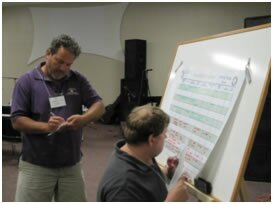AmeriCorps member are among some of the many unsung heroes of Joplin’s May 22 killer tornado.
They were among the first to arrive and will be among the last to return home.
Although not the most well-known federal program, AmeriCorps place over 75,000 Americans in volunteer roles that help citizens and non-profit agencies increase their productivity and effectiveness.
 Bruce Bailey, Director of Americorps-St. Louis, was in Kansas City on business at the time the tornado struck on Sunday evening. He arrived in Joplin by 9 p.m. Members of AmeriCorps-St. Louis were told as early as 7:30 that evening they needed to mobilize. The first team was on the ground in Joplin by 2 a.m.
Bruce Bailey, Director of Americorps-St. Louis, was in Kansas City on business at the time the tornado struck on Sunday evening. He arrived in Joplin by 9 p.m. Members of AmeriCorps-St. Louis were told as early as 7:30 that evening they needed to mobilize. The first team was on the ground in Joplin by 2 a.m.
A total of about 125 AmeriCorps volunteers from a variety of locations are in Joplin.
Bailey says, in terms of disaster caused by tornados, Joplin’s was the worst.
“I have worked in 34 states for at least 20 years, as well as overseas,” Bailey says. “The only thing I can compare the Joplin tornado with was the one in Greensburg, Kan. but that was a much smaller community.”
“I have never witnessed the consequences of something so intense or so powerful as what we’ve seen in Joplin,” he says. “That’s the negative.”
“On the positive side, I have never seen such amazing community cohesion, with people pulling together.”
In the first days after the tornado, hundreds of volunteers arrived in Joplin. Some had medical or nursing training. Some were experts with heavy equipment. But many others had no actual experience outside of their own willingness to work. The job of the AmeriCorps Emergency Response Team (ERT) is to effectively manage these volunteers. It is, at the very least, a big job.
Non-medically trained volunteers were given a number of duties including transferring supplies, finding warehousing opportunities, setting up distribution points and sorting clothes and other supplies.
A large number of those have now gone home.
 Abby Simons an AmeriCorps-St. Louis member who serves as liaison with Missouri Southern State University, says the need for volunteers still exists.
Abby Simons an AmeriCorps-St. Louis member who serves as liaison with Missouri Southern State University, says the need for volunteers still exists.
“Right now, we need people,” the dark-haired young woman in her 20s says. “It’s not a day or two after the storm and many of the people who flooded in have gone home,” she states. “But we don’t want to forget about the need that Joplin still has.”
Simons, originally from Manchester, Mo., and a graduate of Truman State University with a degree in psychology, says volunteer coordination is a must.
“People want to give their time but they may not understand the process of volunteer management,” she says. “Many have never been in a disaster situation. It’s very important that volunteers should not mobilize without being self-sufficient in terms of housing, food and knowing what they are going to do.”
She says those wanting to help should contact the Volunteer Center. It is currently staffed by volunteers. The number to call in Joplin is .
“Make sure you are registered,” Simons says. “This is very important.”
In the first days after the Joplin disaster, people wanting to help lined up outside the Billingsly Student Center at MSSU where the Disaster Response Center was located. Every one of them was registered with AmeriCorps.
“Once we have projects in place, we would like to invite these people back,” Simons says.
Simons will complete her second year of service with AmeriCorps this summer. She had worked in disaster situations even before joining the program. She had taken part in church mission trips and, in college, helped New Orleans area residents after Hurricane Katrina.
“I went down to New Orleans and Mississippi three times,” she says.
The 25 St. Louis AmeriCorps members, plus 44 NCCC volunteers from Denver and 12 from the Washington State, have been sleeping in aerobic rooms and the Phelps Theatre at Missouri Southern. Next week, are in the process of moving to another location on campus during the day and Joplin’s Memorial Hall at night.
Simons says she can’t give enough praise to the MSSU faculty and staff, especially the IT Department which has helped establish computer links to the quickly-established Volunteer Center.
“They have gone above and beyond everything we asked,” she says. “They have supported us in everything we have done. We couldn’t have functioned without them.”
Simons says she knows the AmeriCorps team has been a vital step in the reaction to the Joplin tornado
“I think we have filled a huge role that could not have been managed so effectively if we were not here. This is what we are trained for,” she says.
Bailey says the work of AmeriCorps is by no means finished in Joplin.
“We’ll be providing service to people recovering from the tornado for some time,” he says. “This is especially good for the uninsured and under insured.”As we enter recovery, we’ll be helping out not only with temporary repairs but helping people rebuild their whole households.”

 University of Phoenix is partnering with the HandsOn Network to offer a scholarship program! Together, we are working to provide educational opportunities for individuals that volunteer with HandsOn Network membership programs.
University of Phoenix is partnering with the HandsOn Network to offer a scholarship program! Together, we are working to provide educational opportunities for individuals that volunteer with HandsOn Network membership programs.
 Volunteering is a great way to spend a summer – and teens and young adults may find more than a way to spend some time before school starts up again. They may find something that they never knew they cared about, and their summer at home could start them on the road to a lifetime of service.
Volunteering is a great way to spend a summer – and teens and young adults may find more than a way to spend some time before school starts up again. They may find something that they never knew they cared about, and their summer at home could start them on the road to a lifetime of service. Let them choose their own form of service. Volunteering doesn’t have to be an eight-hour day. It doesn’t have to be in an office. It doesn’t even have to be outside of your home. There are so many different opportunities to volunteer that there’s bound to be something that will grab your students’ interest. You can find opportunities at one of our HandsOn Action Centers, micro-volunteering opportunities at
Let them choose their own form of service. Volunteering doesn’t have to be an eight-hour day. It doesn’t have to be in an office. It doesn’t even have to be outside of your home. There are so many different opportunities to volunteer that there’s bound to be something that will grab your students’ interest. You can find opportunities at one of our HandsOn Action Centers, micro-volunteering opportunities at 
 Be clear about what you want people to do. The volunteer position description serves as an introduction to your organization and to what you’re asking volunteers to do. It’s important to have a clear, easy to read description of what volunteers will be doing with your organization.
Be clear about what you want people to do. The volunteer position description serves as an introduction to your organization and to what you’re asking volunteers to do. It’s important to have a clear, easy to read description of what volunteers will be doing with your organization. Have an escape route. Take the time to draw a floor plan of your home and mark escape routes for each room. Make sure children understand the drawings and have a copy in their rooms. Don’t forget to establish a meeting places in the event of an emergency like a fire.
Have an escape route. Take the time to draw a floor plan of your home and mark escape routes for each room. Make sure children understand the drawings and have a copy in their rooms. Don’t forget to establish a meeting places in the event of an emergency like a fire. To shut off water, locate the shut off valve where the water comes into your home – it may look like this:
To shut off water, locate the shut off valve where the water comes into your home – it may look like this: Have a plan for family pets. Just like you, animals can be affected by disasters. Make sure you know a shelter you can take your pets to in case of an evacuation. Gather together pet supplies and vet records, and make sure your pet has proper ID. Provide a carrier and leash for your pet. You can contact your local emergency management office, animal shelter, or animal control office for more advice or information.
Have a plan for family pets. Just like you, animals can be affected by disasters. Make sure you know a shelter you can take your pets to in case of an evacuation. Gather together pet supplies and vet records, and make sure your pet has proper ID. Provide a carrier and leash for your pet. You can contact your local emergency management office, animal shelter, or animal control office for more advice or information.
 The key to recruiting and retaining boomer volunteers is for nonprofits and volunteer centers to develop an ongoing dialogue with boomers and tailoring service opportunities to meet their needs and desires around service. Here are some tips for focusing on boom recruitment and retention:
The key to recruiting and retaining boomer volunteers is for nonprofits and volunteer centers to develop an ongoing dialogue with boomers and tailoring service opportunities to meet their needs and desires around service. Here are some tips for focusing on boom recruitment and retention:
 Abby Simons an AmeriCorps-St. Louis member who serves as liaison with Missouri Southern State University, says the need for volunteers still exists.
Abby Simons an AmeriCorps-St. Louis member who serves as liaison with Missouri Southern State University, says the need for volunteers still exists.

